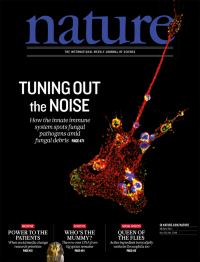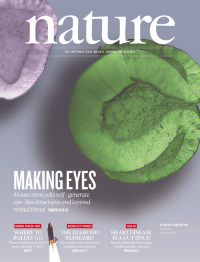Volume 472
-
No. 7344 28 April 2011
Invading microbes are detected and ingested by white blood cells known as phagocytes. To do this the cells must distinguish between soluble microbe-derived components, such as pieces of cell wall, and the particulate microbes themselves. A study of the action of Dectin-1, an innate immune receptor that detects invading fungal pathogens, shows that although the receptor binds to both soluble and particulate cell-wall #x003B2; -glucans, its activation is restricted to sites of contact with fungal cell walls by the formation of 'phagocytic synapses'. The phagocytic synapse provides a mechanistic model for the specific detection of ligands associated with a microbial surface, as opposed to those released from microbes at a distance. On the cover, a murine bone-marrow-derived macrophage (red/green) engages multiple yeast particles (blue).
-
No. 7343 21 April 2011
The world is producing more PhD scientists than ever before. But does the traditional PhD equip researchers to cope with the harsh realities of the modern world? We ask whether its time to take stock and pause the production line. Alison McCook reports on the alternatives being put forward as replacements or quick fixes for the PhD. And in Comment, we gather personal recollections from one-time PhD students, reflecting on seven contrasting decades of the PhD. From the age of formality in the 1950s, through the age of innocence (guess) to the age of communication (thats now). Cover illustration: Oliver Munday
-
No. 7342 14 April 2011
Nearly a year has passed the initial explosion occurred on 20 April since the Deepwater Horizon disaster released millions of barrels of crude oil and methane into the Gulf of Mexico. Mark Schrope reports on the current state of the ecosystem in the region. The biggest impacts are the hardest to spot deep below the ocean surface and at considerable distances from the original spill. On the cover, crude oil from Deepwater Horizon washes ashore in Orange Beach, Alabama, on 12 June 2010. Photo: D. Martin/AP
-
No. 7341 7 April 2011
Organogenesis relies on the orchestration of many cellular interactions to create the collective cell behaviours needed to shape developing tissues. Yoshiki Sasai and colleagues have developed a three-dimensional cell-culture system in which floating clusters of mouse embryonic stem cells can successfully organize themselves into a layered structure resembling the optic cup, a pouch-like structure that develops into the inner and outer layers of the retina during embryogenesis. In further 3D culture, the optic cup forms fully stratified retinal tissue as seen in the postnatal eye. This approach might have important implications for stem-cell therapy for retinal repair. The optic cup shown on the cover was generated from multi-photon images of an optic cup formed in vitro.




